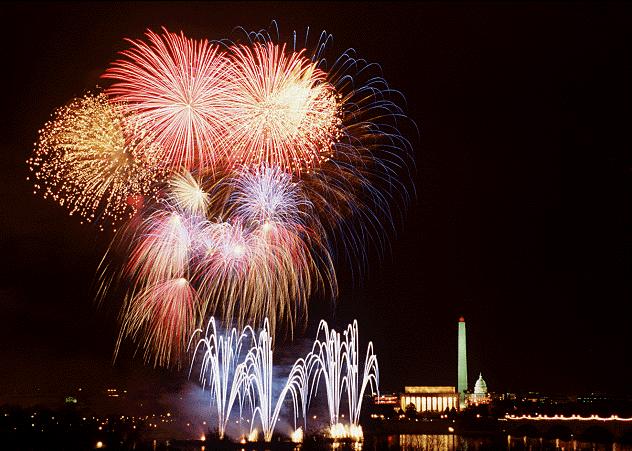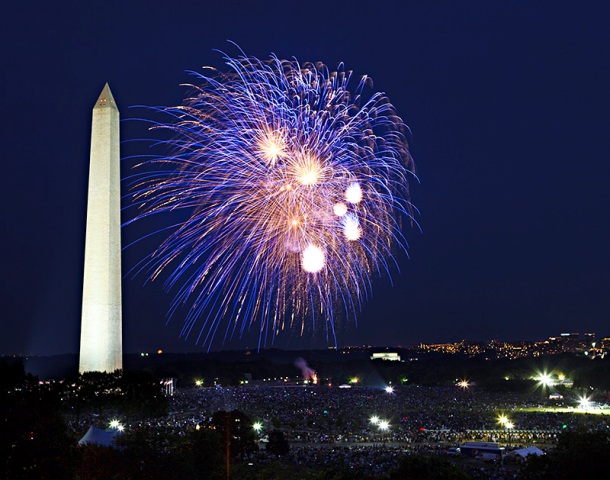How Fireworks Rain Color
After a day of barbeques and parties, it's finally nightfall on July 4th. Suddenly, a boom and flash of light announce the arrival of an intruder into this monochrome world: RED. The color sprouts up above, like a fountain pen spattering an inky hue that stains the sky.

Fireworks during the Clinton Inaugural events of 1993. These red fireworks may have been created using lithium. (Image by Nicholas Parrella from here.)
The syringe that has injected color into the atmosphere is, of course, an aerial firework, propelled from the ground by gunpowder and a lit fuse. The firework is a neat package of chemistry wrapped in paper, a capsule filled with a whole smattering of the periodic table. Wrapped inside it are heavy metals, like lithium, sodium, and potassium; metals you may never have heard of, like strontium and rubidium; elements you eat, like iron, sodium, and zinc; and elements in your lungs, like carbon and oxygen. Some of these are there because they compose the fuel that propels the bundle into the air. Other ingredients create smoke or glitter effects or sparks. And some of them create explosive color.
How does a metal, which in its natural state falls somewhere uninteresting on the white-to-black gradient, create shocking, pure pigment? Contrary to my own expectations, it has nothing to do with magic, and everything to do with fire.
When a material is lit on fire, it -- get ready for a revelation -- gets hot. Heat is a type of energy, the invisible force you can't see but that physicists tell you exists, in your muscles and in a windmill and in light from the sun. When heat energy is soaked up by atoms in an element, it causes a drastic change: it compels an electron, making its merry way around the nucleus, to leap away from the center of the atom as if scalded with a hot iron.
Right and left, all throughout the powdered metal, electrons pop away from their usual abodes, excited by the fiery energy they have absorbed. Moving away from the center of an atom is a big deal for electrons: strongly attracted to the positively charged nucleus, they only hurtle into another orbit when blasted with a particularly large amount of energy.
Not only is this a big jump for an electron to take, but it leaves the whole atom unstable and with too much energy, like a hyperactive third grader. The only solution is for the little particle to return to its normal home, closer to the nucleus. Then everyone involved can take a deep breath and things will return to normal.
But there's the pesky heat to deal with first. It has to go somewhere -- that's the thing with energy: though eternally invisible, it can never just disappear -- and the electron can't return to its normal spot until this surplus oomph has left the atom. So as the little particle makes its way back, it lets the energy go -- but not as heat. Instead, it discharges the energy in a transfigured form: as a photon, which we see as light.

Purple light has the highest frequency of any light. This firework could have been created by burning potassium. (Image by Nicholas Parrella from here.)
As you can imagine, one measly photon doesn't do much to produce an outrageous red. But when billions of atoms release a photon simultaneously, the combined force rains down mammoth amounts of light from the sky.
Although the jumpy electrons theory explains how we see all that light, we still don't know why certain elements bleed certain colors. Depending on the size of the leap that the electron takes when it's heated, the atoms release photons that have different amounts of energy. Photons with more energy emit light at what is called a higher frequency. High-frequency light is purple. The frequency is represented by colors, with blue indicating a slightly lower frequency, green indicating a lower frequency, and red indicating the lowest frequency of all.
That means that if you light strontium on fire, it will create a red blaze. Potassium stains its flame violet. Barium glows green, and copper smolders blue. Each element is like a discrete magic marker that draws a particular color when you put in a little bit of effort, be that pressing firm on paper or lighting with a match.
So even though the elements of the periodic table appear to be drab grays, with a little shove, they unfurl their inner rainbows. Color exists in the most unexpected places. And sometimes, once or twice a year, it's in the skies.
